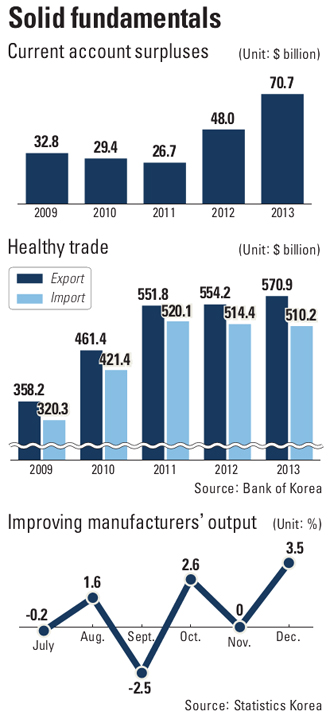Economy ended 2013 on a high

The Bank of Korea yesterday announced the country’s current account surplus broke the all-time record set in 2012 to top the $70 billion mark last year.
The total surplus for 2013 was $70.7 billion, up 47 percent from last year.
It was not only larger than the central bank’s estimate of $64 billion but also far more than 2012’s $48 billion.
In December, the monthly surplus was $6.4 billion, up from $6 billion a month earlier. The biggest monthly surplus was $9.5 billion in October.
The growth in the last month of 2013 was largely thanks to a $44 million surplus in the service account, which swung back from a $700 million deficit in November.
Korea’s current account balance has been in surplus for 23 consecutive months since February 2012.
The annual surplus stemmed from significant increases in exports compared to imports, the central bank said.
In terms of the goods balance, the country had a $60.7 billion surplus, the BOK report stated.
Total exports stood at $571 billion in terms of free-on-board (FOB) prices, while imports were $510 billion.
In terms of customs prices, total exports were $559.6 billion last year, up 2.1 percent from the previous year. This was mainly led by growth in the export of semiconductors (13.3 percent), ICT products (12.1 percent) and electronics (9.8 percent).
By region, exports to the United States (6 percent) and China (8.6 percent) expanded, while those to Japan (-10.6 percent) and the Middle East (-11.8 percent) contracted sharply.
Total imports declined 0.1 percent to $515.5 billion during the same period. Commodity imports dropped 3.7 percent year-on-year.
In December alone, exports climbed 7 percent to $48 billion, and imports rose 3 percent to $44.4 billion.
The service balance also recorded a $6 billion surplus.
BOK officials dismissed worries about a so-called recession-type surplus, which describes an economy with large trade surpluses but sluggish domestic consumption.
“In terms of prices, exports increased and imports declined, but in volume both exports and imports expanded,” said Chung Young-taek, director general of the central bank’s economic statistics bureau. “We can’t agree with the description of a recession-type surplus because imports decreased only as a result of falls in commodity prices.”
The central bank predicted this year’s current account surplus would be $55 billion.
The BOK official expressed confidence in the strong fundamentals of the Korean economy compared to other emerging markets like Argentina and Turkey.
“Argentina and Korea are in totally different situations,” Chung said.
“The Korean economy does have healthy fundamentals based on the strong competitiveness of local businesses.”
Korea’s debt-to-gross-domestic-product level was 36.2 percent in 2013, far lower than the average debt-to-GDP ratio of OECD member countries, which was 108.8 percent in 2012, according to data by the Ministry of Strategy and Finance. Its foreign exchange reserves stood at $346 billion last year.
Proving that Korea’s economic fundamentals are stronger than ever, industries showed robust growth, leading the national economy to a clearer path of revitalization, according to a report by Statistics Korea yesterday.
The country’s manufacturing output showed the largest growth in 54 months, rising 3.5 percent in December, the highest since June 2009. From a year earlier, the figure rose 2.7 percent.
Of all 26 manufacturing sectors, 22 showed increased production.
Total industrial production inched up 0.1 percent in December month-on-month and 1.2 percent year-on-year.
Facilities investment, considered the biggest hurdle for the economic recovery, picked up 5.2 percent in the last month of 2013 from a month earlier and 10.4 percent from a year earlier, owing to increased investment in the transportation equipment industry.
Retail sales slid 1.3 percent in December month-on-month but inched up 0.2 percent year-on-year due to rises in consumption of gasoline and diesel, food and beverages.
The Ministry of Strategy and Finance said in a report that the economy has been increasingly revitalizing since the second half of last year in the areas of production, consumption, investment, exports and employment.
The fourth quarter saw a 3.9 percent jump in gross domestic product, recovering to levels seen before the 2008 global financial crisis hit the country, the ministry said.
Even though domestic consumption dropped in December, the ministry said, retail sales climbed gradually on a quarterly basis, indicating improvement in consumer sentiment.
Investment spiked in the fourth quarter thanks to the government’s efforts in easing business regulations, the report said.
“Despite internal and external risks, signs of economic recovery are getting stronger since the latter part of last year,” a director at the Finance Ministry said. “This year, based on these strong fundamentals, the government will push a three-year economic plan focused on revitalizing the private sector.”
BY song su-hyun [ssh@joongang.co.kr]










with the Korea JoongAng Daily
To write comments, please log in to one of the accounts.
Standards Board Policy (0/250자)